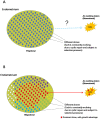From Retrograde Menstruation to Endometrial Determinism and a Brave New World of "Root Treatment" of Endometriosis: Destiny or a Fanciful Utopia?
- PMID: 36830705
- PMCID: PMC9953699
- DOI: 10.3390/biom13020336
From Retrograde Menstruation to Endometrial Determinism and a Brave New World of "Root Treatment" of Endometriosis: Destiny or a Fanciful Utopia?
Abstract
Practically unknown outside of China, the "endometrial determinism" theory was proposed to account for the apparent gap between the relatively low prevalence of endometriosis and nearly universal retrograde menstruation. Attracting uncritical advocacy, the theory culminates in a recent consensus by elite Chinese gynecologists in favor of "root treatment", intended to nip endometriosis in the bud. Correcting endometrial "defects" can gain further momentum by the presence of cancer-driver mutations such as KRAS mutations in the endometrium of women with endometriosis and the recent introduction of therapeutics aiming to rectify the effect of these mutations for cancer treatment. We provide a critical appraisal of evidence for endometrial aberrations in endometriosis and relevant experimental evidence. All available evidence of endometrial "defect" is invariably post hoc and may well be secondary to induced endometriosis. We propose that the theory of "endometrial determinism" needs to demonstrate a clear causal and a phylogenetic relationship between endometrial aberrations and endometriosis. We argue that while it is highly likely that endometriosis is a consequence of retrograde menstruation, the case that molecular aberrations as a sole or a necessary determinant remains to be proven. "Root treatment" is a worthy ambition but as of now it is close to a fanciful Utopia.
Keywords: aberration; causal; endometrial determinism; endometriosis; phylogenetic; retrograde menstruation; root treatment.
Conflict of interest statement
The authors declare no conflict of interest.
Figures


References
-
- Sampson J.A. Peritoneal endometriosis due to the menstrual dissemination of endometrial tissue into the peritoneal cavity. Am.J. Obstet Gynecol. 1927;14:422–469.
Publication types
MeSH terms
Grants and funding
LinkOut - more resources
Full Text Sources
Medical
Miscellaneous

